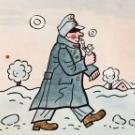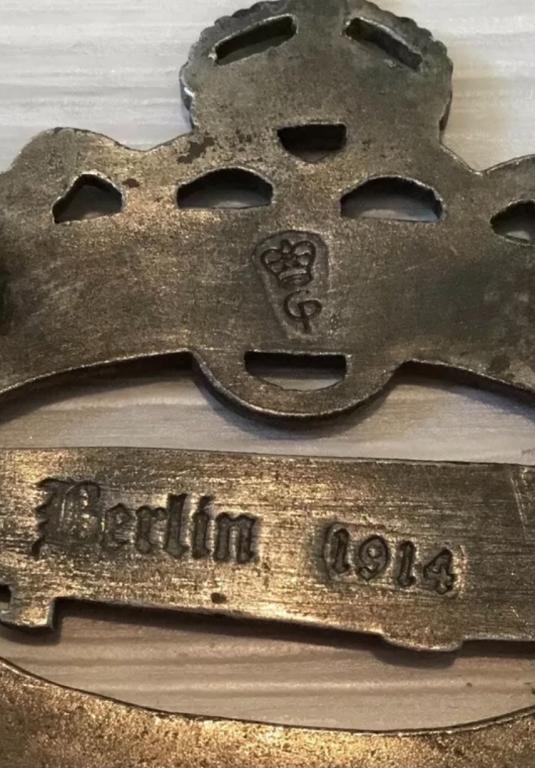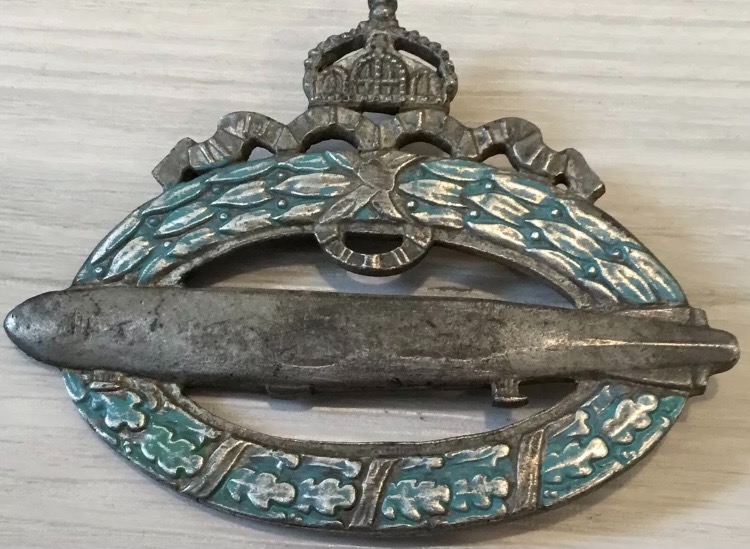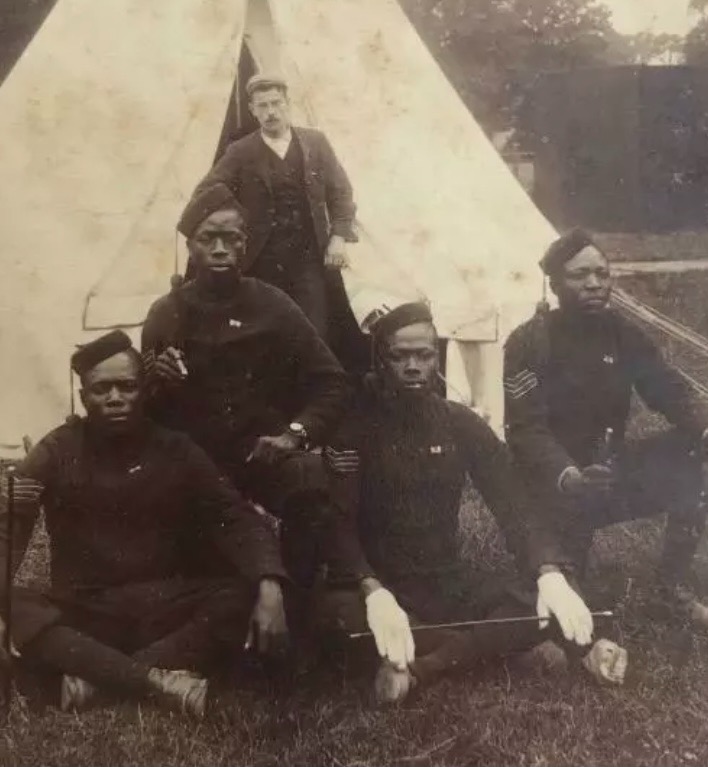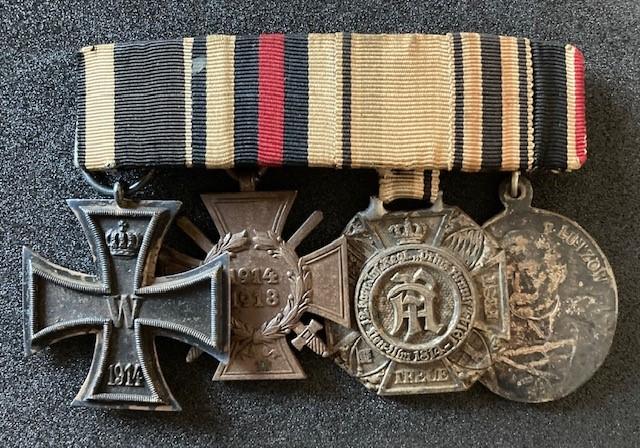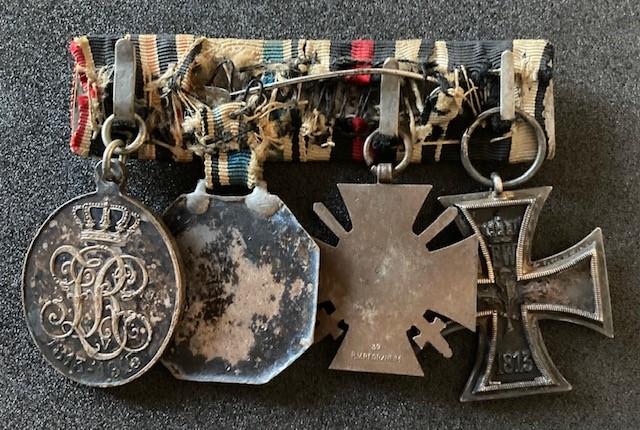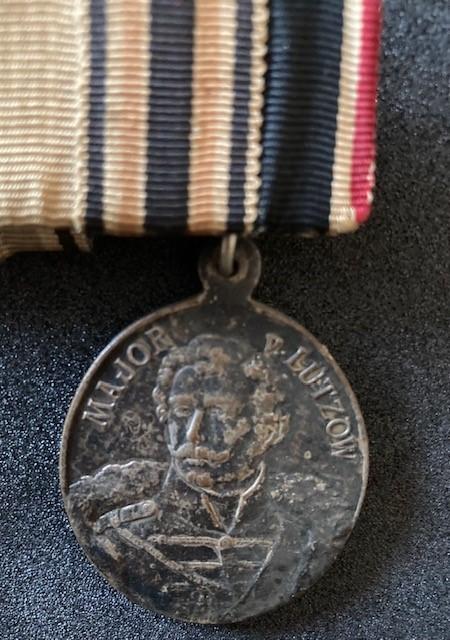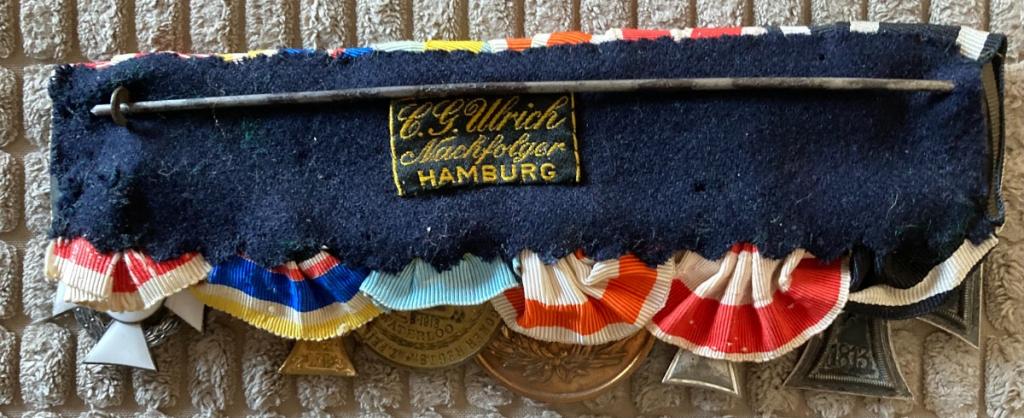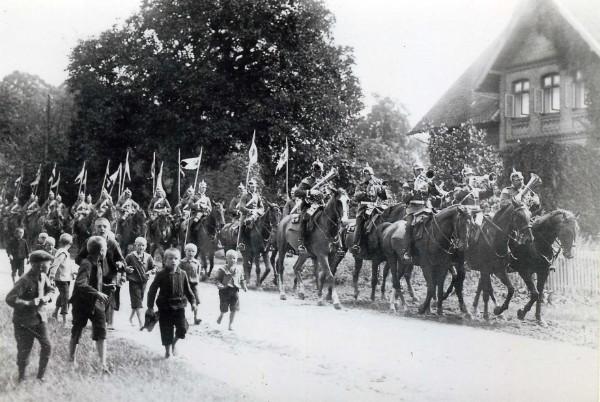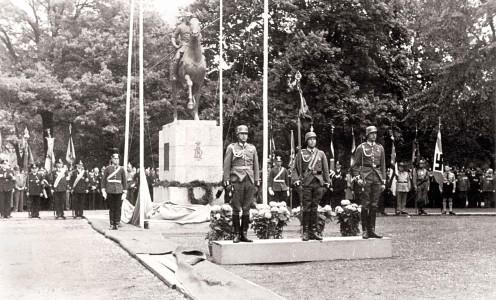-
Posts
41 -
Joined
-
Last visited
Content Type
Profiles
Forums
Blogs
Gallery
Events
Store
Everything posted by Langers
-
Here is a recent purchase from a Saxe-Weimar soldier from WW1. They consist of: • Iron Cross II Class (Prussia) • Military Order of St. Henry Silver Medal (Saxony) • Merit Medal Wilhelm Ernst Bronze (Saxe-Weimar) • Friedrich Cross (Anhalt) • IX Years Service Medal (Saxe-Weimar) The Military Order of St. Henry Silver Medal has a makers mark for F.U. (Friedrich Ulbricht). Sadly no knowledge of the original owner, but this is a delightful group! Stay Safe!
-
I’m with you, thanks for filling me in! it raised a red flag what with the Berlin 1914 markings (seemed very unlikely), but thought I’d double check. It’s probably my naïveté, but it really bothers me that people produce fakes to sell for profit. The whole early post-war replacement issues is fine to me, but people nowadays dumping some modern trash in the garden to weather then sell as original is just downright awful.
-
Here we have an ordensspange consisting of official, and less official, medals which were awarded to a Bavarian soldier of Königlich Bayerische 12. Infanterie-Regiment Prinz Arnulf. It consists of: * Iron Cross II Class * 1914-1918 Hindenburg Medal * 1814-1914 12 Royal Bavarian Infantry Regiment Medal * 1813-1913 Major v. Lutzow Medal The reverse: Other than being a Bavarian, all that can be deduced by this medal group is that he was a pre-war serving soldier (c.1913) who survived until at least 1933. Interestingly, the medal ribbons for the latter two medals are "borrowed" from other veteran associations medals, making the group a little unique. Below I have included a photo of the 1813-1913 Major v. Lutzow Medal for closer examination. Below is a photo of the 1814-1914 12 Royal Bavarian Infantry Regiment Medal for closer examination. 12 Royal Bavarian Infantry Regiment:1814-1914 The Regiment formed in Wurzburg in 1814 and fought during the 1815 Campaign against France. During the 1866 War Bavaria famously sided with Austria, losing to Prussia, later fighting alongside Prussia during the 1870-1871 Franco-Prussian War. Kaisheim Guard Command, 1913 12 Royal Bavarian Infantry Regiment: 1914-1918 The Regiment served exclusively on the Western Front during the Great War. More detail can be read at: Königlich Bayerisches 12. Infanterie-Regiment „Prinz Arnulf“ – Wikipedia 12 Royal Bavarian Infantry Regiment: 1919-1921 Following the Armistice, remnants of the regiment returned to Bavaria (only 193 of the 3,400 original men of the regiment survived). The regiment was demobilised at Neu-Ulm, however, elements joined the Graf Security Battalion of the Freikorps on n1 March 1919. It comprised of four companies, and from May included an additional MG company. The former regimental staff from Königlich Bayerische 12. Infanterie-Regiment Prinz Arnulf formed the staff of Freikorps Wolf in April 1919. The rest of the formation formed in June, alongside 1 Battalion, Reichswehr-Infanterie-Regiment 43. In August 1921 11 Company, 19 (Bavaran) Infantry Regiment took over Königlich Bayerische 12. Infanterie-Regiment Prinz Arnulf. Thanks for reading and feel free to leave any feedback!
-
Well, it may have been partially remounted later down the line. I can’t remember where it came from. Might have been a dealer mate of mine.
- 9 replies
-
- 2. hannoversche dragoner-regiment nr.
- germany
-
(and 3 more)
Tagged with:
-
- 9 replies
-
1
-
- 2. hannoversche dragoner-regiment nr.
- germany
-
(and 3 more)
Tagged with:
-
Blooming marvellous! I came across a description of it online, but seeing it is much better
- 9 replies
-
- 2. hannoversche dragoner-regiment nr.
- germany
-
(and 3 more)
Tagged with:
-
Here we have an ordensspange belonging to a pre-war cavalry officer of 2. Hannoversche Dragoner-Regiment, Nr. 16. The group includes: Iron Cross II Class Hamburg Cross 1912 General Honour Decoration 1813-1913 Regiment Centenary Medal 1914-1918 Regiment Medal Military Merit Cross III Class (Austria) Little is known about the recipient, other than that he was from Hamburg (the bar carries a makers label from Hamburg), was a pre-war serving soldier, and survived until at least the early 1920s. Below is a brief history of the Regiment, as well as a biography of their service history during the Great War. 2. Hannoversche Dragoner-Regiment, Nr. 16: 1813-1913 The Regiment was formed in 1813 during the Napoleonic Wars, and fought at Waterloo in 1815. As a British territory, it served under the Union Flag, and named The Prince Regents Hussars. Later converting to a Dragoon Regiment (Kron Prinz), they fought Prussia during the 1866 War, losing after Langensalza. After Hanovers incorporation into the German Empire they adopted the title 2. Hannoversche Dragoner-Regiment, Nr. 16. They later served in the 1870-1871 Franco-Prussian War. Luneburg: The location of the Regiments HQ. 2. Hannoversche Dragoner-Regiment, Nr. 16: 1914-1919 1914-1916: Flanders & Russian Poland With the outbreak of the First World War and mobilization, a sixth squadron was set up in the regiment, and the Regiment was divided into two semi-regiments (1st, 3rd and 5th squadron, 2nd, 4th and 6th squadron). These were assigned to the 17th and 18th Divisions as divisional cavalry. The units crossed the Belgian border near Liège in the Xth Army Corps and participated in the advance through Northern France. After the withdrawal from the Marne in November 1914, the 1st half-regiment was transferred to the Eastern Front to Russian Poland, where it remained until the end of 1915. In the West, the second half-regiment provided railway and canal protection until 1916. 2. Hannoversche Dragoner-Regiment, Nr. 16, possibly during the Great War 1916: France & Romania After the return of the 1st half-regiment from the East, the regiment was reunited and used for field work in the occupied territories of France. Then the Regimentverband was dissolved again and distributed the individual squadrons to various battlefields, where they were dismounted and used as infantry or as mounted rear-area security. The 6th squadron took part in the campaign in Romania in late 1916. The Military Merit Cross III Class was possibly issued at this time, as in December 1916 Franz Joseph authorised crossed swords to be worn on the ribbon. In January 1919, the regiment returned to Luneburg in an escadron manner, was demobilized and dissolved until 15 March 1919. 2. Hannoversche Dragoner-Regiment, Nr. 16: 1919-1939 Two Squadrons under Bothmer were re-formed into Freikorps von Hndenburg on 8th March 1919, and operated mainly in Pomerania, and in March 1920 in Hanover during the Kapp Putsch. Freikorps von Hindenburg consisted of: 25 officers, 167 Unteroffizierre, 573 men, 139 horses and 10 vehicles 1 Sturmbtl., die Eskadron von Bothmer, 3 Inf.-Komp., 1 MG-Komp., 1 MW-Komp., 1 Schwadron, 1 Nachrichtenzug, 1 Rekrutendepot. On March 10 1920 Eskadron von Bothmer were recieved by von Hindenburg on celebrating the units first anniversary. In June 1921 Eskadron von Bothmer had been engaged in fighting in Obersilesia. On 1 September 1921 the two squadrons of Eskadron von Bothmer disbanded and were incorporated into the Reichswehr. 4th Squadron joined 13th (Prussian) Cavalry Regiment in Luner, 3rd Squadron continuing the tradition of 2 Hanover Dragoon Regiment Nr. 16. 13th Cavalry regiment was dissolved in 1939; its squadrons sent to other cavalry reconnaissance units. Unveiling the 2. Hanoverian Dragoon Regiment Nr. 16 memorial, 17 September 1922 I hope you enjoyed this little piece & feel free to give me any feedback below!
- 9 replies
-
- 2. hannoversche dragoner-regiment nr.
- germany
-
(and 3 more)
Tagged with:
-
Thanks for your input here. To my knowledge, the group is all attributed to Kahle; the first photo of him clearly shows him displaying the complete group. He emigrated to America in 1923, taking the group with him, so, to me, the provenance of the groups originality is there. I can not access the rolls to check if he is on there, and would love to know if he is indeed in it. All the best, Chris



